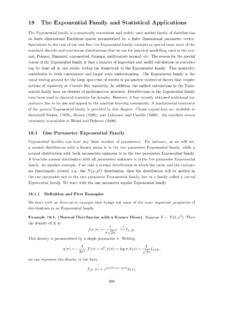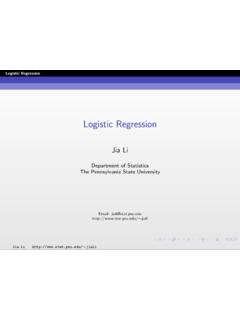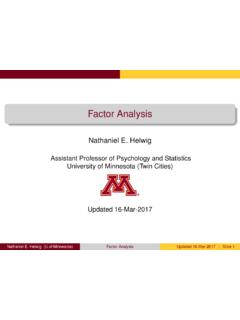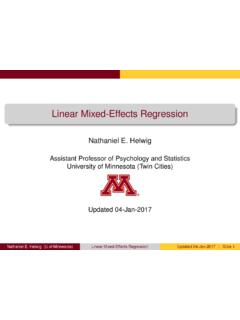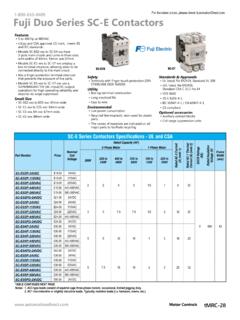Transcription of Abstract arXiv:1607.06450v1 [stat.ML] 21 Jul 2016
1 Layer NormalizationJimmy Lei BaUniversity of Ryan KirosUniversity of E. HintonUniversity of Torontoand Google state-of-the-art, deep neural networks is computationally expensive. Oneway to reduce the training time is to normalize the activities of the neurons. Arecently introduced technique called batch normalization uses the distribution ofthe summed input to a neuron over a mini-batch of training cases to compute amean and variance which are then used to normalize the summed input to thatneuron on each training case. This significantly reduces the training time in feed-forward neural networks. However, the effect of batch normalization is dependenton the mini-batch size and it is not obvious how to apply it to recurrent neural net-works. In this paper, we transpose batch normalization into layer normalization bycomputing the mean and variance used for normalization from all of the summedinputs to the neurons in a layer on asingletraining case.
2 Like batch normalization,we also give each neuron its own adaptive bias and gain which are applied afterthe normalization but before the non-linearity. Unlike batch normalization, layernormalization performs exactly the same computation at training and test is also straightforward to apply to recurrent neural networks by computing thenormalization statistics separately at each time step. Layer normalization is veryeffective at stabilizing the hidden state dynamics in recurrent networks. Empiri-cally, we show that layer normalization can substantially reduce the training timecompared with previously published IntroductionDeep neural networks trained with some version of Stochastic Gradient Descent have been shownto substantially outperform previous approaches on various supervised learning tasks in computervision [Krizhevsky et al.]
3 , 2012] and speech processing [Hinton et al., 2012]. But state-of-the-artdeep neural networks often require many days of training. It is possible to speed-up the learningby computing gradients for different subsets of the training cases on different machines or splittingthe neural network itself over many machines [Dean et al., 2012], but this can require a lot of com-munication and complex software. It also tends to lead to rapidly diminishing returns as the degreeof parallelization increases. An orthogonal approach is to modify the computations performed inthe forward pass of the neural net to make learning easier. Recently, batch normalization [Ioffe andSzegedy, 2015] has been proposed to reduce training time by including additional normalizationstages in deep neural networks. The normalization standardizes each summed input using its meanand its standard deviation across the training data.
4 Feedforward neural networks trained using batchnormalization converge faster even with simple SGD. In addition to training time improvement, thestochasticity from the batch statistics serves as a regularizer during its simplicity, batch normalization requires running averages of the summed input statis-tics. In feed-forward networks with fixed depth, it is straightforward to store the statistics separatelyfor each hidden layer. However, the summed inputs to the recurrent neurons in a recurrent neu-ral network (RNN) often vary with the length of the sequence so applying batch normalization toRNNs appears to require different statistics for different time-steps. Furthermore, batch normaliza- [ ] 21 Jul 2016tion cannot be applied to online learning tasks or to extremely large distributed models where theminibatches have to be paper introduces layer normalization, a simple normalization method to improve the trainingspeed for various neural network models.
5 Unlike batch normalization, the proposed method directlyestimates the normalization statistics from the summed inputs to the neurons within a hidden layerso the normalization does not introduce any new dependencies between training cases. We show thatlayer normalization works well for RNNs and improves both the training time and the generalizationperformance of several existing RNN BackgroundA feed-forward neural network is a non-linear mapping from a input patternxto an output vectory. Consider thelthhidden layer in a deep feed-forward, neural network, and letalbe the vectorrepresentation of the summed inputs to the neurons in that layer. The summed inputs are computedthrough a linear projection with the weight matrixWland the bottom-up inputshlgiven as follows:ali=wli>hlhl+1i=f(ali+bli)(1)whe ref( )is an element-wise non-linear function andwliis the incoming weights to theithhiddenunits andbliis the scalar bias parameter.
6 The parameters in the neural network are learnt usinggradient-based optimization algorithms with the gradients being computed by of the challenges of deep learning is that the gradients with respect to the weights in one layerare highly dependent on the outputs of the neurons in the previous layer especially if these outputschange in a highly correlated way. Batch normalization [Ioffe and Szegedy, 2015] was proposedto reduce such undesirable covariate shift . The method normalizes the summed inputs to eachhidden unit over the training cases. Specifically, for theithsummed input in thelthlayer, the batchnormalization method rescales the summed inputs according to their variances under the distributionof the data ali=gli li(ali li) li=Ex P(x)[ali] li= Ex P(x)[(ali li)2](2)where aliis normalized summed inputs to theithhidden unit in thelthlayer andgiis a gain parame-ter scaling the normalized activation before the non-linear activation function.
7 Note the expectationis under the whole training data distribution. It is typically impractical to compute the expectationsin Eq. (2) exactly, since it would require forward passes through the whole training dataset with thecurrent set of weights. Instead, and are estimated using the empirical samples from the currentmini-batch. This puts constraints on the size of a mini-batch and it is hard to apply to recurrentneural Layer normalizationWe now consider the layer normalization method which is designed to overcome the drawbacks ofbatch that changes in the output of one layer will tend to cause highly correlated changes in thesummed inputs to the next layer, especially with ReLU units whose outputs can change by a suggests the covariate shift problem can be reduced by fixing the mean and the variance ofthe summed inputs within each layer.
8 We, thus, compute the layer normalization statistics over allthe hidden units in the same layer as follows: l=1HH i=1ali l= 1HH i=1(ali l)2(3)whereHdenotes the number of hidden units in a layer. The difference between Eq. (2) and Eq. (3)is that under layer normalization, all the hidden units in a layer share the same normalization terms and , but different training cases have different normalization terms. Unlike batch normalization,layer normaliztion does not impose any constraint on the size of a mini-batch and it can be used inthe pure online regime with batch size Layer normalized recurrent neural networksThe recent sequence to sequence models [Sutskever et al., 2014] utilize compact recurrent neuralnetworks to solve sequential prediction problems in natural language processing. It is commonamong the NLP tasks to have different sentence lengths for different training cases.
9 This is easy todeal with in an RNN because the same weights are used at every time-step. But when we apply batchnormalization to an RNN in the obvious way, we need to to compute and store separate statistics foreach time step in a sequence. This is problematic if a test sequence is longer than any of the trainingsequences. Layer normalization does not have such problem because its normalization terms dependonly on the summed inputs to a layer at the current time-step. It also has only one set of gain andbias parameters shared over all a standard RNN, the summed inputs in the recurrent layer are computed from the current inputxtand previous vector of hidden statesht 1which are computed asat=Whhht 1+Wxhxt. Thelayer normalized recurrent layer re-centers and re-scales its activations using the extra normalizationterms similar to Eq.
10 (3):ht=f[g t (at t)+b] t=1HH i=1ati t= 1HH i=1(ati t)2(4)whereWhhis the recurrent hidden to hidden weights andWxhare the bottom up input to hiddenweights. is the element-wise multiplication between two defined as the biasand gain parameters of the same dimension a standard RNN, there is a tendency for the average magnitude of the summed inputs to the recur-rent units to either grow or shrink at every time-step, leading to exploding or vanishing gradients. Ina layer normalized RNN, the normalization terms make it invariant to re-scaling all of the summedinputs to a layer, which results in much more stable hidden-to-hidden Related workBatch normalization has been previously extended to recurrent neural networks [Laurent et al., 2015,Amodei et al., 2015, Cooijmans et al., 2016]. The previous work [Cooijmans et al.]

![arXiv:0706.3639v1 [cs.AI] 25 Jun 2007](/cache/preview/4/1/3/9/3/1/4/b/thumb-4139314b93ef86b7b4c2d05ebcc88e46.jpg)

![arXiv:1301.3781v3 [cs.CL] 7 Sep 2013](/cache/preview/4/d/5/0/4/3/4/0/thumb-4d504340120163c0bdf3f4678d8d217f.jpg)
![@google.com arXiv:1609.03499v2 [cs.SD] 19 Sep 2016](/cache/preview/c/3/4/9/4/6/9/b/thumb-c349469b499107d21e221f2ac908f8b2.jpg)





